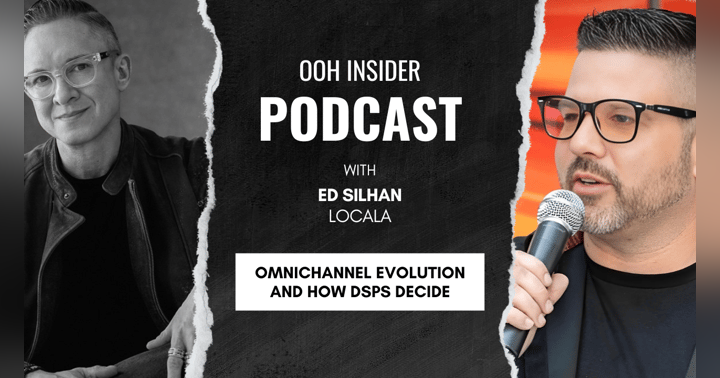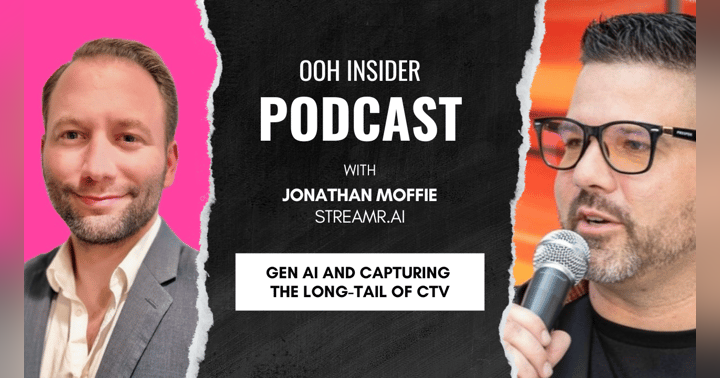Unleashing the Power of OOH Advertising: A Holistic Approach to Measuring ROI and Optimizing Campaigns - Part V

In 2013, British Airways launched a digital billboard campaign in London's Piccadilly Circus that used surveillance technology to track planes flying overhead. When a British Airways flight passed by, the billboard would display the flight number and destination, along with a message encouraging people to "Look Up" and consider where the flight could take them.
According to a case study by the advertising agency Ogilvy, the campaign generated significant buzz and engagement. In the first two weeks alone, the campaign received over 1.3 million tweets and reached over 40 million people on social media. British Airways also reported a 62% increase in bookings during the campaign period, compared to the same time the previous year.
And while I'm all for a great case study that pulls a new brand into testing OOH for the first time, the reality is we have to be looking for those stories every time. To keep brands engaged. To create marketing hypotheses to test and optimize feedback loops. To prove OOH is a predictably scalable growth channel that is wildly undervalued.
Where It Starts - The Needs Analysis
Starting with a thorough client needs analysis is essential because it helps ensure that the strategy and tactics are aligned with the client's objectives and target audience. Here are some reasons why a thorough client needs analysis is important:
-
Understanding the client's business objectives: Conducting a client needs analysis helps the marketing team understand the client's business objectives, which can vary depending on the industry, target audience, and market conditions. By understanding the client's objectives, the marketing team can develop a marketing strategy that is aligned with those objectives and helps the client achieve their desired outcomes.
-
Identifying the target audience: A thorough client needs analysis helps the marketing team identify the client's target audience, including demographics, interests, behaviors, and pain points. This information is critical for developing messaging and recommending tactics that resonate with the target audience and drive the outcomes we care most about - engagement and conversions.
-
Evaluating the competition: Understanding the competitive landscape is crucial for developing a marketing strategy that sets the client apart from their competitors. By conducting a client needs analysis, the marketing team can evaluate the strengths and weaknesses of the competition and identify opportunities to differentiate the client's brand.
-
Establishing key performance metrics: A thorough client needs analysis helps the marketing team establish key performance metrics, such as CPA, CAC, AOV, and LTV, which are essential for measuring the effectiveness of the marketing strategy and optimizing tactics for better results.
KPIs are metrics used to measure the performance of a marketing campaign or strategy. If you're helping brands with advertising, it's not your job to be responsible for them but it is your job to understand why they matter to the client and what they're counting on you for in achieving those objectives.
-
CPA (Cost per Acquisition): This metric represents the cost of acquiring one customer. By tracking the CPA, marketers can determine the effectiveness of their campaigns and optimize their spending to maximize their return on investment.
-
CAC (Customer Acquisition Cost): This metric represents the total cost of acquiring a customer over a specific period. CAC includes all expenses related to acquiring new customers, such as marketing costs, sales commissions, and onboarding expenses.
-
AOV (Average Order Value): This metric represents the average value of each order placed by a customer. By increasing the AOV, marketers can generate more revenue from each customer and improve their overall profitability.
-
LTV (Customer Lifetime Value): This metric represents the total value a customer brings to the business over their lifetime. By understanding the LTV, marketers can make informed decisions about how much to spend on customer acquisition and retention.
It's also really helpful to understand these things when telling a holistic attribution story. An effective feedback loop consists of multiple data points, collaboration, and a willingness to look for the simplest explanation and challenge it with an earnest desire to discover. And scale like crazy. 🚀
A Hyperlocal Way To Get Started (For Anyone, Big or Small)
OOH ads are typically displayed in specific geographic locations, such as billboards along highways or posters in subway stations, and are meant to reach people who are physically present in those areas. Because of that hyper locality and because the awareness that becomes interest typically turns up first on Google (see also: TikTok), Google Analytics can be a great way to get started quantifying the impact and measuring the return on your OOH campaign.
Lift and Decay
When we talk about lift and decay in advertising, what we mean is - "how much better or worse things are going because of the ads we show people". If the ads are really good and lots of people start buying things, that's lift! But if we launch a campaign and things go the other way, that's decay. It's kind of like a see-saw, where we want the lift to be stronger than the decay so we can keep going up!
Google Analytics and Google My Business 101
So, when a company is advertising in a specific area, they may want to know if their ads are actually reaching and influencing people in that area. This is where measuring lift and decay through Google Analytics or Google My Business can provide actionable insight.
For example, let's say a local company has decided on advertising in a few specific towns in their market. By using Google My Business, they can see how many people from those towns are finding their business listing and visiting their website or calling them.
If more people from that neighborhood are looking for (and finding) the company after the ads go up, that means the business saw a lift. But if fewer people from that neighborhood are calling and visiting the business, that there has been decay.
Neither is attributable to the ad directly (unless using a vanity/call-tracking phone number in the creative) but it can be used as directional feedback and used to prove or disprove a marketing hypothesis.
This same measurement strategy with Google My Business scales regionally and nationally and is a worthwhile exercise to setup and have as input for your measurement methodology.
Similarly, by using Google Analytics, companies can measure for changes in behavior from a specific geographical region (most useful is typically 'city') for the periods before, during, and after a campaign.
If more people from the area of the campaign visited the website, again, there was lift. If fewer people visited, that means decay. And again, not attributable for anything, but directionally helpful.
A List Of Things To Test And Measure For
Via Google Analytics
- Average Engagement Time - How sticky is the traffic? Are visitors from areas where there is an OOH presence spending more engaged time on the website? If so or if not, what could it mean?
- Engaged Sessions Per User - Are visitors from areas where there is OOH coming back more frequently than visitors where there isn't? What's the value of a visitor coming back more frequently? Does it represent an accelerated sales cycle? Higher lifetime value?
- Conversions - New Users are up but Conversion is down? That may or may not be a bad thing depending on your business. Traffic is flat but Conversion is up in areas where there is an OOH presence? It could be that there isn't more market share to be had but that existing prospects are likelier to convert.
All testable hypotheses, available right now, today, for free, inside of Google analytics.
A Few Key Google Analytics To GA4 Nomenclature Changes To Watch For:
- New Users are now tracked under "User acquisition"
- Returning Users are now tracked under "User retention"
- Conversion Rates are now tracked under "Conversion events" or "Conversion rate"
- Goals are now tracked under "Events" or "Measurement ID Goals"
Via Google MyBusiness
Google My Business provides a feature called "Insights," which allow companies to track several key metrics related to their listing. Here are some examples of metrics that can be measured using Google My Business:
-
Total searches: This measures how many times you appeared in local search results on Google Search and Google Maps.
-
Direct searches: This measures how many times customers searched for your company name or address directly.
-
Discovery searches: This measures how many times customers found you through a category, product, or service search.
-
Customer actions: This measures how many customers took action on your listing, such as visiting your website, requesting directions, or calling your phone number.
-
Phone calls: This measures how many times customers called your company using the phone number listed on your Google My Business profile.
-
Direction requests: This measures how many times customers requested directions to your business using the Google Maps app.
-
Store visits: This measures how many times customers visited your business location after finding it on Google.
By tracking these metrics, before, during, and after an advertising campaign you can observe for changes in the behaviors and key metrics that matter most.
Oh and here are a few other things that could be cool to test for changes in:
- Social CPMs/Engagement
- AdWords Optimizations (reduced CPC, increased CTR, impression share, etc.)
- Direct Mail Open Rates
- SMS Response Rates
- Telephone Prospecting Response Rates
Some Helpful Holistic Formulas
They all generally do the same thing, but each industry has its own particular flavor that is most useful for them.
For SaaS companies, it's LTV:CAC:
What is the Lifetime Value of a customer (total amount of money they will spend with me while they are my customer) divided by the Cost to Aquire a Customer (total amount of money spent on sales and marketing combined).
For example, it costs $1 to acquire a customer whose lifetime value is $4, therefore my LTV:CAC ratio is 4:1
For an e-commerce company, it may be nCPA:AOV:
The normalized Cost Per Acquisition, fully baked, what does it cost to acquire one customer? Relative to the Average Order Value, rather total sales divided by total orders.
(For a local gym, it might be $150 to acquire a customer whose lifetime value will be $1,200, no fancy formula or acronyms required)
For Two-Sided Marketplaces, Total Amount Spent / Total Amount of Customers Acquired
Pretty self-explanatory and I like this one most because it came directly from Layne Cox, CMO of Union and a true pioneer of Startups using OOH as a growth lever, on how she personally measured the impact of an omnichannel media strategy at Seamless (Grubhub in NYC).
(Check out the interview here)
Questions to ask when managing a marketing investment:
- Am I spending more and getting less?
- Am I spending less and getting more?
- Am I spending the same and getting more/less?
With OOH it's not 1+1=2, it's 1+1=3.
Measuring OOH is truly a layer cake.
It's art and science.
And it's the alchemist's favorite dessert.
-Tim Rowe
Read the other parts of the multi-part measurement series here and be sure to subscribe to my curated daily newsletter (M-F) of what I'm reading and listening to, to stay ahead of the curve.



